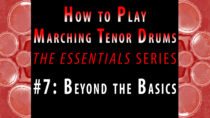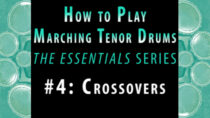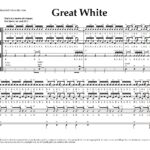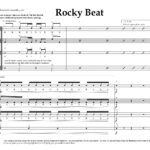The final installment is here: today we go beyond the basics of multi-tenor drumming! So far, we have covered the essential skills every tenor drummer should know. Now I bring you more advanced concepts that are sure to Read more “How to Play Marching Tenor Drums, part 7 of 7: Beyond the Basics”
Tag: multi-tenors
How to Play Marching Tenor Drums, Part 4 of 7: Crossovers
It’s crossover week! Check out the newest video:
This 7-part series becomes more interesting as crossovers–a true staple of tenor drumming–are explored in a variety of ways. This video covers 13 crossover patterns, including a long “Crossover Builders” exercise that goes through all 18 crossover positions.
The “Crossover Builders” exercise and a transcript of the video are included below. Just a reminder: If you don’t already have Read more “How to Play Marching Tenor Drums, Part 4 of 7: Crossovers”
New Section for Drum Line Cadences – Downloadable Sheet Music
A new cadence section has been created in the Free Stuff section at the top of the page. Check out these new cadences posted for your listening and playing enjoyment. More will be added in the future, but here are three to get you started.
Some of the cadences are free, and some of them cost a little bit. Overall, we want to keep these affordable and accessible for any drum line that wants to play them. Generally speaking, the free ones have a simple structure and are just fun to play. The ones available for purchase are a little more involved and took more effort to create. If you like this site and the music, please consider supporting it through purchasing one of the cadences. Thanks!
Great White – FREE
Difficulty: 2.5 – This catchy cadence gets faster and faster on each repetition. This requires some control on accented singles, 6-stroke rolls, and syncopated 16th note rhythms. It should be accessible for an average high school or good junior high drum line.
Click here to download as a PDF.
Rocky Beat – FREE
Difficulty: 1.5 – This simple cadence consists of a three-measure groove followed by a four-count solo, each time performed by a different drum line member. The solos here are just examples. They can be easy or difficult. It’s a fun opportunity to show off some improvisation and creativity! The snare line needs to be able to play a basic rock groove, which requires a little bit of independence coordination between each hand, but it should be fairly quick to learn for most percussionists who have been playing for at least a year. This cadence should be accessible for an average junior high drum line. (A high school can also have fun with it by making the solos flashier and harder!)
Click here to download as a PDF.
Bad bASS – $4.97
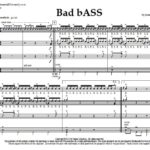
Difficulty: 4.5 – You may recognize this cadence as the “soundtrack” for many other videos on this site. It starts confidently with a hard-thumping bass groove and showcases some fun feature moments for every section. The snare and tenors need to be able to play their flam rudiments. Flam taps, pataflaflas, and flamacues are just some of the rudiments you’ll encounter. The bass line has split 16th note triplets and 32nd notes, some syncopated 16th notes splits, and double stroke rolls in the top two parts. The recording features five bass drums, but an alternative four-bass part is included with the purchase. (If you have six bass drums, just double the bottom part.) The cymbal part is written for two or more players, but one person can combine the parts if needed. This cadence has drive. It has attitude. It’s bad a$$. This cadence should be accessible for an average college or good high school line.
Multi-Tenor Drum Etude #19: “Fibonacci”
This “nerdy” tenor solo is dedicated to math geeks everywhere! This is multi-tenor drum etude #19 from The Art of Multi-Tenor Drumming. The main theme is derived from the Fibonacci sequence, and it focuses on developing sweeps, a.k.a. scrapes, around the drums.
Here are the performance notes from the book:
I originally thought of titling the next three etudes Sweep Fest #1, Sweep Fest #2, and Sweep Fest #3. (I ultimately settled on that title for etude #21 alone.) The idea was that each of the three etudes would focus on sweep patterns, but they would increase in difficulty. This idea still generally holds true, but a few ideas came to me based on mathematics, and they lent themselves to sweeps quite well. I think this gives the following etudes a very interesting structure, much more interesting than what I would have created if I was simply trying to write a sweep etude from scratch.
I was reading how the Fibonacci sequence is used in the music of Bartók, Debussy, Satie, and others. This gave me the idea to do a few experiments. The main theme of this etude, Fibonacci, is derived from the Fibonacci number sequence. In short, Read more “Multi-Tenor Drum Etude #19: “Fibonacci””
Multi-Tenor Etude #6: “Double Crossed”
Here is a visually exciting tenor solo from The Art of Multi-Tenor Drumming. The book contains 33 multi-tenor etudes, and this is etude #6 entitled “Double Crossed.” As the title suggests, the focus is on developing crossovers.
Here are the performance notes from the book:
This flashy etude utilizes an abundance of crossovers. The first half begins with an 8th note pattern. The second half, beginning with measure 16, utilizes the same pattern with doubles on every note. Both halves feature a repeated section—the first time through at mezzo-forte, the second time at fortissimo. Be careful not to play the mezzo-forte section too loudly; otherwise the contrast will be obscured, or you will be forced to overplay the fortissimo section. Stark dynamic contrast will really help to sell the ideas in this solo. There is a more intricate 16th note sweep section during the last two lines. Take care to aim for the proper beating spots to avoid rims. You may want to review the 16th note doubles section in the rudimental exercises [contained in the book].
Thanks for watching. If you enjoy the video, please “like” it and share it with your friends!
Multi-Tenor Etude #7: “The Fool in the Mirror”
Bit by bit, I am posting videos of the etudes from my book The Art of Multi-Tenor Drumming. This is multi-tenor etude #7 entitled “The Fool in the Mirror.” Its main theme is pretty catchy, and it focuses on developing 16th note patterns around the drums.
Here are the performance notes from the book:
There is nothing in this etude exceptionally flashy from a visual standpoint, but the melody is quite catchy, and this is one of my favorite etudes to play in this book. (Of course, I think all of the etudes are great!) The whole piece gradually moves from playful syncopated rhythms to more intense driving rhythms, but it returns to a light-hearted note at the very end. The first section (mm. 1-5) establishes the playful syncopated main theme. The second section (mm. 6-9) contrasts the first with a slightly less syncopated 8th note double stop quasi-groove pattern. The third section (mm. 10-13) is a more driving segue that reiterates the main ideas of the first section. The fourth section (mm. 14-19) is the longest (with repeats), and it is the most driving; it has very little syncopation, and it focuses on some basic paradiddle patterns mixed with doubles and 16th note singles rhythms. The final section (mm. 20-22) is the shortest, and it caps off everything by quickly highlighting the previous themes.
Enjoy the video!
Multi-Tenor Etude #27: “Maze”
Here is the next installment of videos from my book The Art of Multi-Tenor Drumming. In addition to thousands of exercises, the book contains 33 etudes. This is etude #27 entitled “Maze.”
Here are the performance notes from the book:
This etude is dedicated to DCI snare champion, Ken Mazur. His books have done a lot to help me grow in my playing, and they were a great inspiration to me in writing this book. The etudes in this section were largely inspired by the “Rudimental Performance” etudes in his orange book [The Basic Technique of Rudimental Drumming]. In fact, this etude can be played as a duet with the final “Rudimental Performance” etude, or it can be played as a stand-alone solo. If played as a duet, the first two measures are a solo introduction, and the snare part would come in on measure 3. I have always loved the snare etude, and I thought it would be nice to have a tenor version of it. (With the added arounds and sweep patterns, the tenor part is slightly more difficult, but you have to be a pretty good player to play either version well.)
In adapting this etude to tenors, I looked to the Marty Hurley/Lee Hansen snare/tenor duets, such as Phantom of the Phield and Phantom Phrenzy. Of course, Ken Mazur was a student of Marty Hurley, and you can hear Hurley’s influence in Mazur’s writing. The Hurley solos were originally written as stand-alone solos. Later, Lee Hansen (another student of Hurley’s) wrote tenor accompaniments that could be played as either a stand-alone tenor solo or a duet with the snare part. These solos were all written for quads (four drums), and I decided to do the same here.
As you play through this etude, you will find that the structure has a really good sense of momentum, and a lot of different rudiments are incorporated. It’s a lot of fun to play, and there are several rudimental surprises throughout. Whether you play it as an individual solo or as a duet with a good snare drummer, it should thoroughly engage any audience.
I hope you enjoy the video!
Multi-Tenor Etude #11: “Believe It or Not”
At the beginning of the year, I announced that I intended to record a number of the etudes from my book The Art of Multi-Tenor Drumming. There are 33 etudes total, and here is my first video toward that goal. This is etude #11 entitled “Believe It or Not.”
Here are the performance notes from the book:
This lively etude is intended to be a good overview of fundamental skills. The initial theme is presented in the introduction and hinted at throughout the rest of the solo. Each subsequent section works on a specific skill—movement patterns, triplet rolls, crossovers, flams, odd-metered time signatures, tuplets, extended 32nd note rolls, and extended 24th note singles. Finally, the original theme is reprised, concluding with a final challenge of rapid fire dynamic changes. All of this is packed into 34 energetic measures. Younger players should take this at a moderate tempo, as it will serve as a good solo for incorporating fundamental techniques. More advanced players will find it a challenge to take a more lively tempo. The etude works well at a variety of tempos.
I hope you enjoy the video!
Multi-Tenors Exercise: Helicopters, Butterflies, & Figure Eights
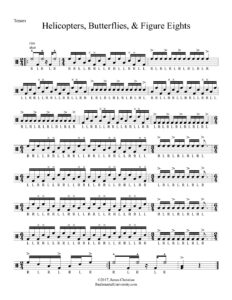
Here is a new exercise for marching tenors that focuses on the three most common crossover sweep patterns: helicopters, butterflies, and figure eights.
In case you are unfamiliar with these terms, helicopters are found in measures 2 and 4. Butterflies are found in measures 6 and 8. Figure eights are found in measures 10 and 12. The final pattern, found in measures 14 and 16, is not as common, but it makes logical sense in the context of this exercise. I call the pattern inward figure eights. With all of these patterns, they are presented first with right hand lead and then with left hand lead.
All these sweep patterns are based on the visual “picture” created from their movement when played rapidly. Helicopters look a bit like helicopter blades moving. Butterflies create sort of a butterfly wing shape. Figure eights create an “8” shape. Inward figure eights follow the same motion, but the sweeps move inward instead of outward.
The measures that do not contain sweeps are meant as a groovy check pattern. I find the accent and rim shot patterns more fun to play than a measure of straight singles (or something similarly basic). I suspect most readers will enjoy them more as well.
This exercise is great for all ability levels. Beginner players will want to take each measure very slowly in order to learn these patterns. You may need to start around 80 beat per minute (bpm) on the metronome. Advanced players may be able to treat the exercise in more of a double time fashion, playing in a tempo range of 240 bpm—or faster!
As always, focus on proper playing zones. Avoid rim clicks and aim for 100% accuracy. Maintain even sounding doubles, so that both notes are of equal volume. Enjoy!
Announcing the Ultimate Tenor Book:
“The Art of Multi-Tenor Drumming” by James Christian
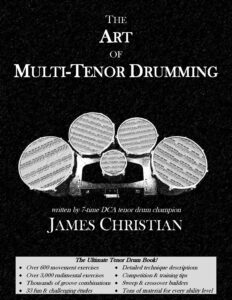
I am happy to announce that my new book The Art of Multi-Tenor Drumming is now available to order. It has taken me the better part of a decade to write it, and I believe drummers everywhere will find it worth the wait. For decades, drum set, keyboard percussion, snare drum, and timpani have had several detailed texts written for them. Now tenor drums finally get their turn. This is the book that the tenor world has been waiting for.
At 366 pages, this is the most thorough book ever written on the art of tenor drumming. It covers the absolute basics and lays a solid foundation for beginners, while giving intermediate and advanced players plenty of material to challenge them as well. This book has been a true labor of love, and I hope people will enjoy playing from it as much as I enjoyed writing it. I offer this book as an opportunity to raise the bar and set a new standard for the next generation.
Click on the link below to see the product page and learn more.
https://www.rudimentaluniversity.com/product/art-of-tenor-drumming/

